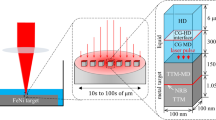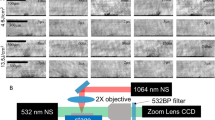Abstract.
In the present work, we have studied ablation of a silver metal surface with a Nd:YAG laser (355 nm, 0.8 J/cm2, 6 ns) on the basis of measured data. We have solved the nonlinear heat conduction equation for the laser heating of the system and calculated the varying surface temperature and evaporation rates. These realistic experimental input parameters are further combined with a direct simulation Monte Carlo (DSMC) description of collisions in the gas flow of ablated surface atoms.
With this method, new data of plume development and collision processes in the beginning of the ablation process can be extracted. It also allows us to identify important processes by comparing the computational results with experimental ones, such as density, energy, and angular distributions.
Our main results deviate only slightly from an earlier study with constant surface temperature and evaporation rate at times t≫τlaser, and this demonstrates that at these later times, the collisions in the plume efficiently smear out the characteristics of the varying temperature at the surface during ablation. The physical properties of the gas flow are determined by the mean thermal energy in the initial plume as well as the number of monolayers emitted.
Similar content being viewed by others
Author information
Authors and Affiliations
Additional information
Received: 21 July 1999 / Accepted: 31 August 1999 / Published online: 28 December 1999
Rights and permissions
About this article
Cite this article
Ellegaard, O., Schou, J. & Urbassek, H. Monte Carlo description of gas flow from laser-evaporated silver . Appl Phys A 69 (Suppl 1), S577–S581 (1999). https://doi.org/10.1007/s003390051479
Issue Date:
DOI: https://doi.org/10.1007/s003390051479




